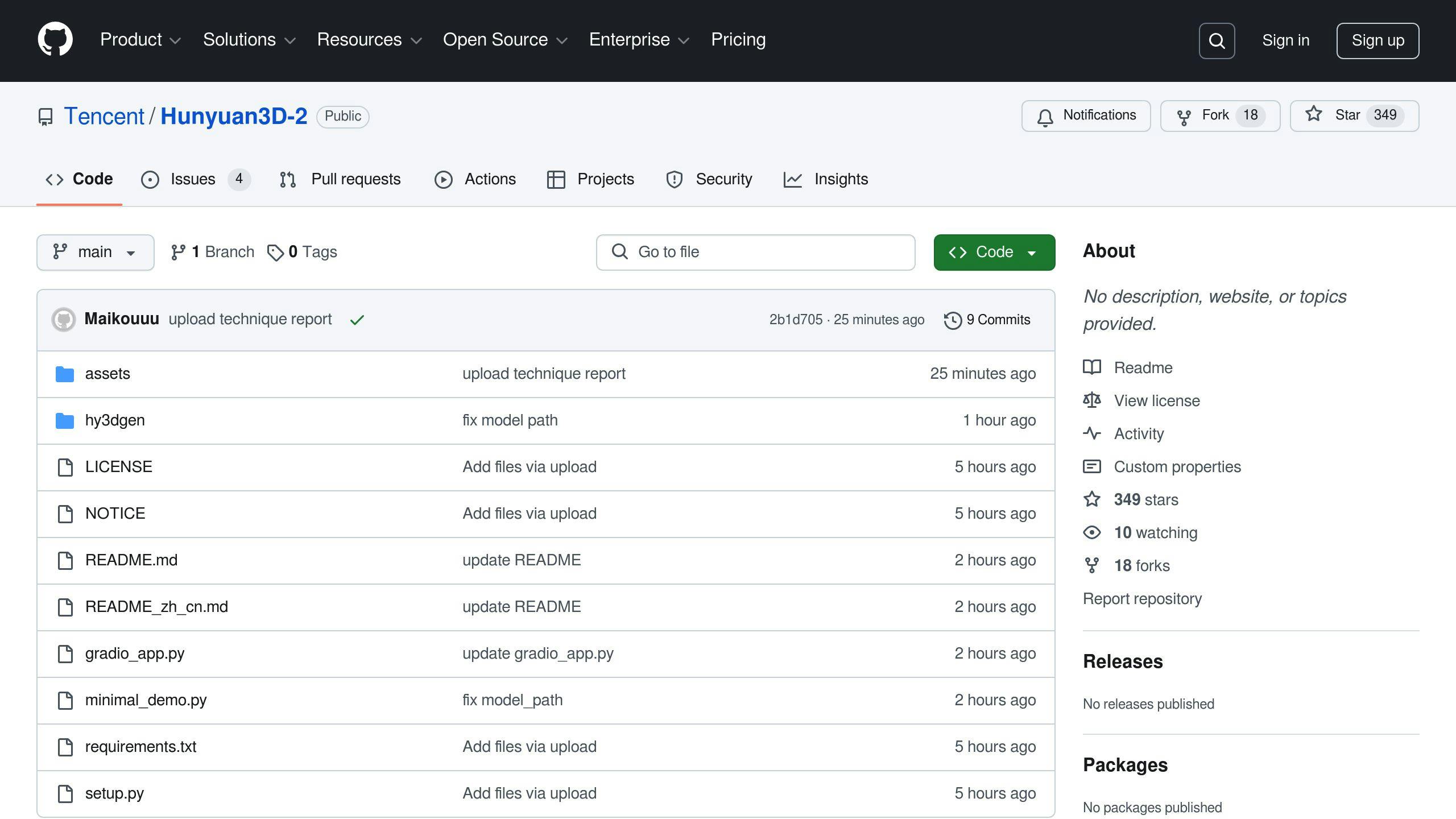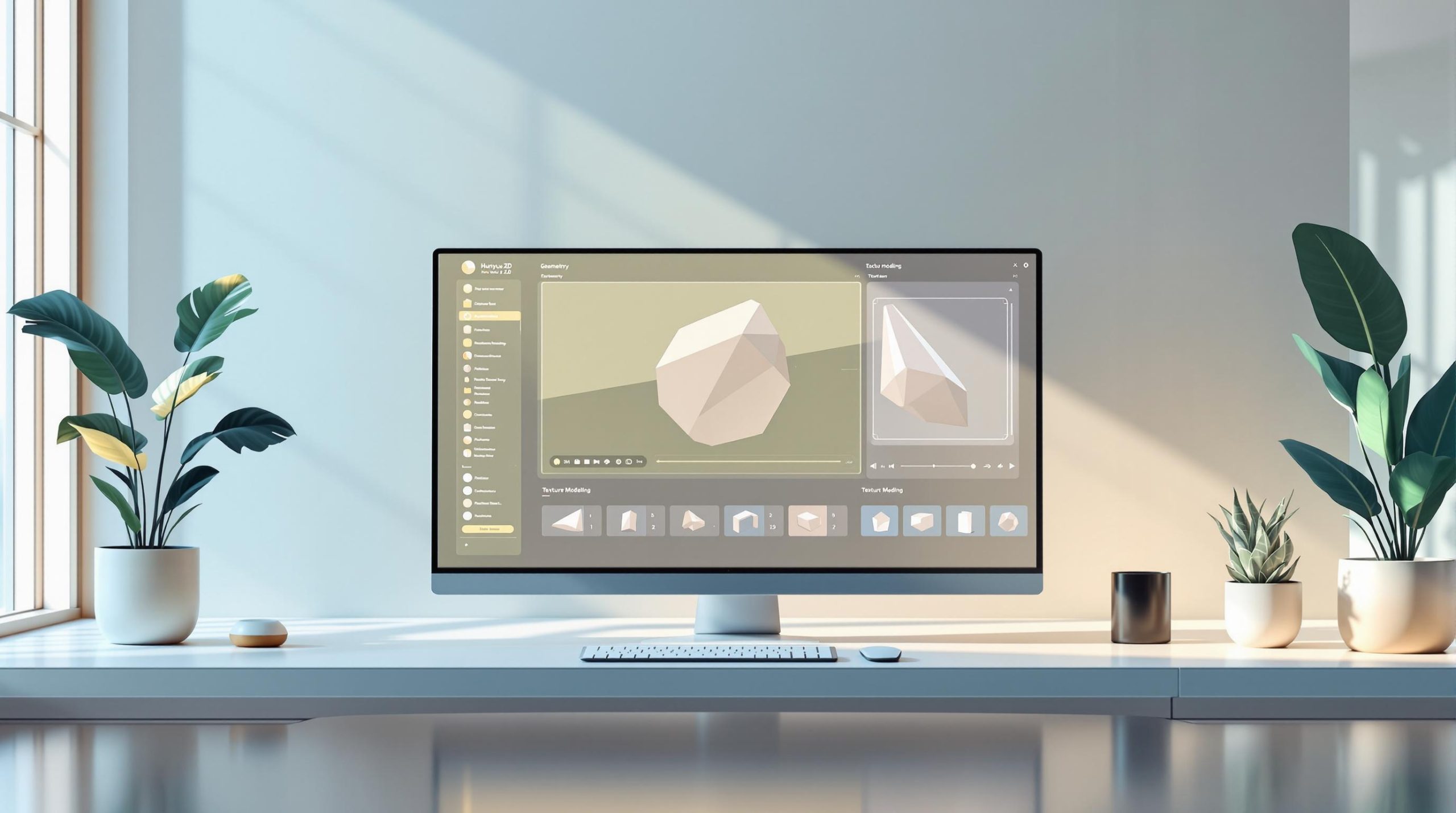Hunyuan 3D 2.0 is Tencent‘s open-source 3D foundation model designed to simplify 3D content creation. It uses a two-stage pipeline: Hunyuan3D-DiT generates shapes, and Hunyuan3D-Paint adds textures, producing high-quality 3D assets from text or image prompts. With top-tier metrics like CMMD (3.193) and CLIP-score (0.809), it leads in precision and quality for industries like gaming, animation, and VR.
Key Features:
- Two-Stage Process: Separate pipelines for shape creation and texture application.
- 3D VAE: Ensures detailed geometry and high-resolution textures.
- Multi-Modal Large Language Model (MLLM): Enhances text-prompt interpretation.
- Open-Source: Available on platforms like GitHub and Hugging Face.
- Speed: Generates models in ~10 seconds per task.
Strengths:
- High-quality 3D assets with precise geometry and textures.
- Open-source and accessible for integration into workflows.
- Proven efficiency (e.g., Tencent Maps improved productivity by 91%).
Weaknesses:
- High computational demand (best with NVIDIA RTX 4090 or A100 GPUs).
- No sound integration.
- Potential biases in text prompt processing.
Quick Comparison Table:
| Aspect | Strengths | Weaknesses |
|---|---|---|
| Architecture | Advanced generation pipeline | Requires powerful hardware |
| Performance | Exceptional metrics | No sound integration |
| Accessibility | Open-source availability | Resource-intensive to operate |
| Output Quality | High-resolution assets | Potential text processing biases |
| Speed | ~10 seconds per generation | Hardware-dependent performance |
For developers in gaming, VR, or animation, Hunyuan 3D 2.0 offers a powerful tool for generating precise, high-quality 3D assets. However, it requires robust hardware to fully leverage its capabilities.
Features and Capabilities of Hunyuan 3D 2.0

Unified Image and Video Generation
Hunyuan 3D 2.0 leverages a Transformer-based architecture to handle both image and video generation effortlessly. It combines Hunyuan3D-DiT for creating shapes and Hunyuan3D-Paint for adding textures, enabling an end-to-end process for crafting 3D assets. This setup eliminates the need to switch between different tools, streamlining the workflow for creators [3].
The model’s process separates mesh creation from texture generation, offering the flexibility to texture both AI-generated and manually designed meshes effectively [1]. Additionally, its integrated 3D VAE ensures top-tier output quality.
3D Variational Autoencoder (VAE) for Superior Results
The built-in 3D VAE is a cornerstone of Hunyuan 3D 2.0, ensuring high-quality 3D model generation. Here’s a breakdown of its key features:
| Feature | Description |
|---|---|
| Geometric Detail | Accurately captures intricate 3D shapes |
| Texture Synthesis | Produces high-resolution textures |
| Optimization | Balances performance with quality |
This technology is already making a difference in real-world use cases. For instance, Tencent Maps employs Hunyuan 3D 2.0 to generate 3D navigation icons, boosting efficiency by an impressive 91% [3].
Enhanced Prompt Interpretation with MLLM
The Multi-Modal Large Language Model (MLLM) component significantly improves the model’s ability to interpret text prompts, ensuring accurate and visually appealing results [1]. Its performance is reflected in impressive industry metrics, such as a CMMD score of 3.193 and a CLIP-score of 0.809, highlighting its capability to deliver precise, high-quality 3D assets [1].
These features make Hunyuan 3D 2.0 a powerful tool for industries like gaming, animation, and VR, where top-notch 3D assets are a must.
Strengths and Weaknesses of Hunyuan 3D 2.0
Strengths of Hunyuan 3D 2.0
Hunyuan 3D 2.0 stands out with its advanced architecture, offering flexibility and producing high-quality 3D assets. It delivers top-tier performance metrics, surpassing many open and closed-source alternatives [1]. For instance, Tencent Maps reported a 91% boost in efficiency when using this model, highlighting its practical effectiveness.
Being open-source, it is available to developers and creators globally. This accessibility makes it a valuable tool for industries that rely on efficient, high-quality 3D asset generation [1].
Weaknesses of Hunyuan 3D 2.0
One major drawback is its high computational demand, which can be a barrier for users with limited hardware capabilities [1]. Additionally, the lack of sound integration restricts its use in audio-visual projects. Another issue is potential biases in text processing, which might affect prompt accuracy and, consequently, the quality of the generated 3D output [1].
While these limitations may pose challenges for some users, those with adequate resources can take full advantage of the model’s advanced features.
Comparison Table of Strengths and Weaknesses
Here’s a quick overview of Hunyuan 3D 2.0’s strengths and weaknesses:
| Aspect | Strengths | Weaknesses |
|---|---|---|
| Architecture | Advanced generation pipeline | Requires powerful hardware |
| Performance | Exceptional metrics | No sound integration |
| Accessibility | Open-source availability | Resource-intensive to operate |
| Output Quality | High-resolution 3D assets | Potential text processing biases |
| Processing Speed | ~10 seconds per generation [2] | Performance depends on hardware |
These factors are key in evaluating whether the model fits specific projects or development needs. Knowing its capabilities and limitations helps developers make well-informed choices when deciding to integrate Hunyuan 3D 2.0 into their workflows.
Other Tools Similar to Hunyuan 3D 2.0
Alternative Tools to Consider
The 3D and video generation space is packed with options, each catering to different needs. TikTok Symphony Creative Studio stands out for its user-friendly video production tools, perfect for integrating with popular editing software. Luma Dream Machine specializes in AI-driven 3D models and animations, while Synthesia is a go-to for creating educational and marketing videos. WonderShare Virbo focuses on detailed 3D modeling with advanced mesh editing and texturing features.
| Tool | Primary Focus | Technical Expertise Required | Best Use Case |
|---|---|---|---|
| TikTok Symphony | Video Production | Beginner-Friendly | Social Media Content |
| Luma Dream Machine | 3D Animation | Advanced Knowledge Required | Creative Projects |
| Synthesia | Video Generation | Moderate Learning Curve | Educational Content |
| WonderShare Virbo | 3D Modeling | Advanced Knowledge Required | Detailed 3D Assets |
How Hunyuan 3D 2.0 Compares to Other Tools
Hunyuan 3D 2.0 sets itself apart with its top-tier metrics like CMMD and CLIP-score, ensuring high-quality 3D model outputs [1]. Its two-stage process for generating meshes and textures delivers consistently reliable results [3].
While tools like Luma Dream Machine prioritize ease of use, Hunyuan 3D 2.0 offers developers unmatched flexibility through its open-source framework. Available on platforms like GitHub and Hugging Face, it’s an excellent choice for those needing a customizable solution tailored to specific projects [1].
This tool’s ability to handle complex geometry and texture modeling makes it ideal for gaming, animation, and VR, where precision matters most. However, its computational demands might be higher compared to more user-friendly commercial tools.
For developers seeking a high-performance 3D generation tool with customization options, Hunyuan 3D 2.0 stands out as a strong contender in the industry.
sbb-itb-5392f3d
Using Hunyuan 3D 2.0 in Your Projects
Example Code for Text-to-Video
Hunyuan 3D 2.0 uses a two-step process to simplify 3D content creation. By separating mesh generation from texture application, it gives users more control over customization. Here’s an example of how to generate and texture a 3D model using its pipelines:
from hy3dgen.shapegen import Hunyuan3DDiTFlowMatchingPipeline
from hy3dgen.texgen import Hunyuan3DPaintPipeline
# Initialize pipelines
shape_pipeline = Hunyuan3DDiTFlowMatchingPipeline.from_pretrained('tencent/Hunyuan3D-2')
texture_pipeline = Hunyuan3DPaintPipeline.from_pretrained('tencent/Hunyuan3D-2')
# Generate 3D mesh and apply textures
mesh = shape_pipeline(image='assets/demo.png')[8]
textured_mesh = texture_pipeline(mesh, image='assets/demo.png')
# Save the final model
textured_mesh.save("final_model.obj")
This process allows you to refine meshes and textures separately, making it easier to tweak designs. It’s especially useful in areas like gaming and animation, where iterative improvements and high-quality results are critical [3].
System Requirements for Running the Model
To get the best performance, make sure your system meets these requirements:
| Component | Minimum Requirement | Recommended Specification |
|---|---|---|
| GPU | NVIDIA RTX 3080 | NVIDIA RTX 4090 or A100 |
| RAM | 16GB | 32GB or higher |
| Storage | 50GB SSD | 100GB NVMe SSD |
| Python Version | 3.8 | 3.9 or higher |
The hardware requirements reflect the model’s ability to handle demanding 3D tasks [1]. For smoother operation, ensure your system includes proper CUDA support and ample storage for the model and generated assets.
With the right setup, Hunyuan 3D 2.0 can streamline the creation of 3D assets, making it a powerful tool for your projects.
Summary and Final Thoughts
Key Takeaways
Hunyuan 3D 2.0 reshapes 3D content creation with advanced geometry and texture modeling, simplifying workflows while improving output quality. Its design ensures precise alignment between geometry and textures, making it a go-to tool for a range of industries [3].
The model’s performance is backed by its CMMD score of 3.193, setting a benchmark for geometry accuracy [1]. Tencent Maps’ adoption further highlights its ability to handle large-scale production efficiently without compromising quality, proving its reliability in demanding environments [3].
While the model does require significant hardware resources, its strengths in delivering precise, high-quality assets make it a favorite for industries like gaming, animation, and VR, where accuracy and dependability are essential [1].
These advancements solidify Hunyuan 3D 2.0 as a key tool in today’s 3D content creation landscape.
Final Thoughts
Hunyuan 3D 2.0 stands out with its impressive performance metrics and easy accessibility via platforms like GitHub and Hugging Face. Its success in practical applications, such as gaming and 3D mapping, showcases its transformative impact on these industries [1].
The model’s achievements in user-generated content creation, product material synthesis, and large-scale 3D mapping highlight its versatility and practical use cases [3]. As AI-driven 3D modeling continues to advance, Hunyuan 3D 2.0 is set to remain a leader, shaping the future of 3D content creation.
FAQs
What is the best AI for generating 3D models?
Hunyuan 3D 2.0 stands out with a CMMD score of 3.193 and a CLIP-score of 0.809, making it a top choice for professional uses like gaming and VR [1]. Its two-stage pipeline (explained earlier) delivers high-quality geometry and textures, which is especially useful for industries needing precise 3D asset creation [3].
With its open-source availability and proven performance in professional settings, Hunyuan 3D 2.0 is a reliable option for developers and creators looking for advanced 3D model generation tools [1].
Can AI generate 3D models for games?
Absolutely. Hunyuan 3D 2.0 is capable of creating game-ready 3D models, offering key features tailored for game development. It generates low-polygon designs for better performance, high-resolution textures for enhanced visuals, and supports animations for dynamic elements. Its precise geometry ensures accurate collision detection, making it highly practical for game developers [1].
The model has proven its usefulness in areas like UGC creation and product visualization [3]. By unifying geometry and texture generation, it simplifies the asset creation process, allowing developers to efficiently produce high-quality 3D content [1].
These features make Hunyuan 3D 2.0 a powerful tool for creators and developers working in gaming and interactive media.

